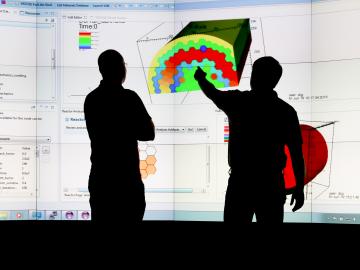
Filter News
Area of Research
News Topics
- 3-D Printing/Advanced Manufacturing (3)
- Advanced Reactors (2)
- Artificial Intelligence (5)
- Big Data (3)
- Biology (1)
- Biomedical (1)
- Buildings (2)
- Climate Change (2)
- Computer Science (10)
- Cybersecurity (1)
- Energy Storage (1)
- Exascale Computing (2)
- Grid (2)
- High-Performance Computing (5)
- Machine Learning (3)
- Materials Science (1)
- Mathematics (1)
- Microscopy (1)
- National Security (2)
- Neutron Science (1)
- Nuclear Energy (3)
- Quantum Computing (1)
- Quantum Science (1)
- Simulation (1)
- Software (1)
- Space Exploration (1)
- Summit (4)
- Transformational Challenge Reactor (1)
- Transportation (2)
Media Contacts

In the early 2000s, high-performance computing experts repurposed GPUs — common video game console components used to speed up image rendering and other time-consuming tasks

A software package, 10 years in the making, that can predict the behavior of nuclear reactors’ cores with stunning accuracy has been licensed commercially for the first time.

Nuclear scientists at Oak Ridge National Laboratory have established a Nuclear Quality Assurance-1 program for a software product designed to simulate today’s commercial nuclear reactors – removing a significant barrier for industry adoption of the technology.

Oak Ridge National Laboratory scientists have created open source software that scales up analysis of motor designs to run on the fastest computers available, including those accessible to outside users at the Oak Ridge Leadership Computing Facility.


Computer scientists at Oak Ridge National Laboratory have developed an open source software platform that allows quantum programs to run on multiple quantum computers regardless of their unique architecture.

Nuclear scientists at Oak Ridge National Laboratory are retooling existing software used to simulate radiation transport in small modular reactors, or SMRs, to run more efficiently on next-generation supercomputers. ORNL is working on various aspects of advanced SMR designs through s...

A precision approach to treating snow- and ice-covered roads, developed by an Oak Ridge National Laboratory-led research team, aims to help cities effectively allocate resources and expand coverage on roadways. The combined software and hardware technology analyzes existing city data and uses high-resolution modeling to identify areas most vulnerable to drivers during hazardous weather conditions.

Inspired by her computer science studies and the possibilities of 3D-printing, intern Elizabeth Yeoh-Wang found a way to combine those pursuits as she worked on a software project at the Manufacturing Demonstration Facility (MDF) at Oak Ridge National Laboratory (ORNL) last summer. Elizabeth, a r...



